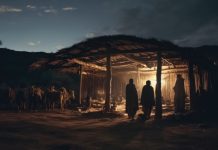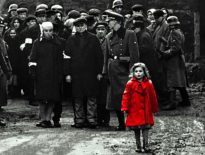The Spanish flu filled graves in almost every cemetery in the world. However, surprisingly, this tragedy had largely been forgotten until recently. A century later, the issue returned to the centre of attention, with specialists wondering if they can identify a pattern in the evolution of the COVID-19 health crisis based on the pandemic from a century ago.
No one suspected, in the early spring of 1918, that a major disaster would hit most regions of the world, killing between 2.5 and 5% of their inhabitants. The danger came in the form of a microorganism that claimed far more lives than the weapons of World War I did.
On the morning of March 4th, 1918, Albert Gitchell, a cook in the Funston military unit in Kansas, presented to the infirmary with a fever, headache and a sore throat. By noon, more than 100 people would arrive at the infirmary with similar symptoms and, in the following weeks, the number of patients increased so rapidly that the chief physician of the unit requisitioned a hangar to house the patients.
A virus that’s deadlier than the war
In truth, no one knows to this day whether Gitchell was patient zero or not. There are several theories about the origins of the Spanish flu (it allegedly had broken out in China or France), but it certainly did not start in Spain. In May, when the flu eventually hit Spain, its residents were unaware that the disease was already silently spreading in the United States and France, and that local authorities were censoring any news that could have affected soldiers’ morale. Spain was neutral, so news about the flu circulated unhindered there. Soon, the French, the British and the Americans came to call the disease “Spanish flu”, without later revisiting this not-so-innocent mistake.
When asked what the biggest disaster of the last century is, people think of the two world wars, the spectacular episodes of colonisation, or the rise and fall of communism, but almost no one names the Spanish flu, notes Laura Spinney, a journalist who writes on subjects related to science, in her book, Pale Rider: The Spanish Flu of 1918 and How It Changed the World. Ironically, three years after the publication of the book, the Spanish flu is on the lips of many, precisely because the Coronavirus pandemic has revived our interest in past pandemics, as well as the similarities between them and the current crisis.
The 1918 flu took the world by surprise, Spinney notes, explaining that at the time, only diseases considered to be a public health risk were being reported on, and the flu did not fall into this category.
Without reports (other than sporadic ones, made by doctors who realised they were dealing with a serious illness), it was not possible to centralise the data, so governments did not recognise early enough what was happening.
On the other hand, governments treated the flu as an appendage of the war. The British government, for example, silenced a memorandum submitted to the Royal Society of Medicine by public health expert Sir Arthur Newsholme, who strongly recommended that those who had any symptoms of the disease should avoid crowds and stay at home. Finally, even the expert admitted that, no matter how welcome these distancing measures proved, there are “certain circumstances in which the major duty is to ‘carry on’, even when risk to health and life is involved.“
Eventually, the flu could not be ignored anymore. In the fall of 1918, the second wave of the flu hit several regions, and it was the most virulent of all three. If up until then all efforts had been focused on keeping soldiers healthy and on the battlefield, now authorities had to take care of the civilians as well, writes Jim Harris, a historian of science at Ohio State University.
“What is this?”
Before the world realised that it was facing a pandemic and not a series of local epidemics, a newspaper from Freetown, the capital of Sierra Leone, suggested that the mysterious disease should be called “manhu” (a Hebrew word meaning “what is this?”, by which the Israelites manifested their astonishment when they received manna, as they made their way through the wilderness).
They were right to be dismayed by the disease that decimated families and communities. The flu was attacking mostly young people and acting so quickly that, in some cases, it would only take a few hours from the sudden onset of symptoms to death.
If during the first wave of the pandemic most of the patients recovered, the second wave caused a much more serious form of the disease. Patients had trouble breathing, they were bleeding from their noses and mouths, and the two brown spots that appeared on their cheeks quickly spread over their entire faces, then to the rest of their bodies, until it was impossible to tell white persons from people of colour, according to a doctor at a Detroit military hospital. In his letter to a friend from September 1918, he recounted the large number of deaths among the medical staff, the exhaustion of those who remained to do their duty, and confessed that he was terrified that the number of deaths had remained at about 100 a day.
“Several doctors expressed their intention to commit minor crimes in order to be imprisoned during the pandemic,” Maurice Jacob, an English doctor, noted, explaining that despite the risks, fears and exhaustion, doctors took care of their patients until the end.
By October, the deaths had become so numerous in Rio de Janeiro that people were simply tossing the bodies out of the window for public services to take care of. Sometimes the bodies were left in the street for days on end, and the air became unbreathable. The gravediggers could no longer keep up, so the pits were dug quickly and it was not uncommon to see the foot of a corpse protruding from a shallow pit, according to writer Nelson Rodrigues.
In India, the second wave broke out in September of 1918, overlapping with a severe drought. People begged for water and fought for it among themselves. Half of the population was ill (even Gandhi was affected by the flu), so there was not enough labour to harvest the first annual crop and sow the second. In fact, there were so many dead that their bodies had crowded the rivers, because there was not enough wood to burn them.
What frightened the population especially was the arbitrary way in which the flu seemed to choose its victims, although subsequent research showed that social position, lifestyle and genetics played a role in the degree of vulnerability to the disease, writes Spinney.
Those living in certain parts of Asia, for example, were up to 30 times more likely to die from the flu. In India alone, between 13 and 18 million people died, probably more than World War I had killed. Even though Asia and Africa had the highest number of casualties, (with Europe, North America and Australia having the lowest), there were variations in mortality within the continents as well.
Denmark lost 0.4% of its population, and in Hungary and Spain the losses were almost three times higher. The United States and Britain lost 0.5% of their population, China lost between 4 and 9.5 million people, and the death toll in Russia is estimated at 2.7 million.
After reviewing the mortality rate, in 1998, Australian historian and geographer Niall Johnson and historian Jürgen Müller estimated that the death toll from the Spanish flu was 50 million (of which 30 million were from Asia), but stressed that the figure could be underestimated by as much as 100%.
Why, in 2020, are we talking about a pandemic from a century ago?
At first glance, the two pandemics seem difficult to compare due to the differences between them: from the mortality rate, to the progress made in the fields of medicine, hygiene and public health over the last 100 years.
However, some researchers have argued that even in terms of mortality, in some cities the two pandemics do not differ that much. Thus, the authors of a study published in the Jama Network Open showed that the death toll of the COVID-19 surge in New York City this spring was only 30% lower than the one generated by the Spanish flu during its peak in the city. Many compare COVID-19 to seasonal flu, while at the same time seeing the Spanish flu as an unparalleled disaster, says Jeremy Faust, a physician at Brigham and Women’s Hospital in Boston and the study’s coordinator.
This time, the bodies were no longer stacked on the road, but in refrigerated trucks, says Faust, arguing that he wants “people to realise the magnitude of the drama we witnessed this spring, because what we are seeing again now is truly historical”.
During a pandemic, researchers usually calculate excess mortality from all causes, a method used during a crisis to show the difference between deaths that occur in a normal period of time and those that occur because of the crisis. It is estimated that approximately 33,500 people died in New York (out of a population of 8.3 million) between March 11 and May 11, 2020, resulting in 202.8 deaths per 100,000 inhabitants. In these two months, the overall death rate was more than four times higher than the average of the same months from the previous three years.
In comparison, in the two peak months of the Spanish flu (October-November 1918), 31,589 deaths were registered in New York among a 5.5 million population, which means an average of 287.17 deaths per year per 100,000 inhabitants (more than 3 times the mortality rate in the city in the 3 years preceding the pandemic). The bottom line is that the mortality rate in New York was 70% of that of 1918, even without the ventilators and high-tech ways to save lives we have available today (in 1918, neither antibiotics or antiviral drugs were being used).
We don’t know how high the mortality rate would have gone in 1918 without having the technology and drugs available now. In 2020, however, “we’re worse off today than in 1918“, precisely because technological advancement should have helped us to save many more lives, says Faust.
An extensive analysis made by The New York Times showed that while we are far from the nightmare death toll of the 1918 flu, COVID-19 has few rivals in modern history in terms of mortality.
“The past is not a prediction,” said Mari Webel, an assistant professor of history at the University of Pittsburgh, and Megan Culler Freeman, a physician specialising in infectious diseases in children at the same university. They analysed a number of differences, including the fundamental differences between the biology of SARS-CoV-2 and that of influenza viruses, and concluded, in an April study, that it is difficult to establish the trajectory of COVID-19 by looking at the 1918 pandemic. The two pandemics will most likely not follow the same pattern, the authors say. In fact, the WHO claimed at the end of July that the term “second wave” was inaccurate and we should refer rather to “a big wave” of COVID-19, given that the virus does not know seasonal variations, as the flu virus does.
Lessons from a finished pandemic
For the past two years, Spanish historians Laura and María Lara Martínez have been studying the Spanish flu pandemic, and after the WHO declared the coronavirus a pandemic, they felt as if they had jumped into a time machine in which parts from the past were being revived before their eyes.
In 1918, at first people thought they were dealing with a common cold. However, as the toll from the disease rose, a number of measures were taken to prevent its transmission. In the US, for example, public spaces were disinfected, theatres and schools were closed, in some areas wearing a mask became mandatory (the fines for violating this rule went up to $100), people were trained to follow hygiene rules, and traffic restrictions were imposed, as was the quarantine of those suspected of contamination.
The most important lesson we can learn from the way the 1918 crisis was handled is about truth and trust, writes John M. Barry, a professor at the School of Public Health and Tropical Medicine at Tulane University.
Barry points out the antagonistic way in which city residents reacted, according to information received from the authorities. In the US, the government, and most often the local authorities as well, hid the severity of the disease, so when the epidemic hit hard, the population became terrified, lost not only confidence in the authorities but compassion for their fellow people, each fighting savagely for their own survival. In cities where people were properly informed about what was happening, the reactions were different: in San Francisco, the mayor, doctors and businessmen together signed an announcement about the severity of the flu, ending with a capital letter message: “WEAR A MASK AND SAVE YOUR LIFE! ” In the end, the community mobilised to fight the disease, with teachers volunteering, after schools were closed, to work as ambulance drivers, telephone operators, or food suppliers.
An equally valuable lesson we could learn is about the power of influencing and the (self) deception of unverified theories. In the way the people of Rio related to the information about the flu transmitted by the Department of Public Health, we see many of the reactions that COVID-19 has aroused today.
In their October 12, 1918 issue, the satirical magazine Careta wondered if this disease, the “killer of the elderly” (in fact, mostly young people were its victims), was being used by the authorities as pretext to impose “scientific tyranny” and violate human rights. The epidemic was dubbed by the media as “Seidl’s devil” (Carlos Seidl being the city’s director of public health at the time), and politicians ridiculed the idea that microbes can travel through air. By the end of the month, 500,000 inhabitants, half of the city’s population, were suffering from the flu, and the gravediggers couldn’t keep up with burying the dead, with up to 1,000 coffins pending. Despite all the evidence, however, there were still opinion leaders in Rio who argued that the disease that brought the city to its knees was not the flu.
A very important lesson we have learned from the Spanish flu is that social distancing works, and the effect is most efficient when “we act early, act fast and stick together—and base our decisions not on social or economic concerns, but on science and data and facts” says Christopher Nichols, a history professor at Oregon State University.
For each country, the end of the pandemic depended, eventually, on “the information and training of specialists and the interests of the political class,” writes historian Jaume Claret Miranda. In the historian’s view, the most important lesson that the past teaches us is that any measure considered exaggerated before the pandemic proves insufficient at the end of it.
During the Spanish flu pandemic, American cities (such as San Francisco, St. Louis, Milwaukee or Kansas City) that imposed timely public health measures, such as wearing a mask and banning meetings, reduced transmission rates by 30-50% and mortality by up to half, showed a study published in 2007.
The fact that there were cities that managed to significantly reduce mortality by only taking a few hygiene and distancing measures, without vaccine, treatment or the medical resources available today, is a ray of hope for us, says Dr. Stefan Pambuccian, from the Medical Center of Loyola University, Chicago. On the other hand, as soon as the Spanish flu ended, everyone went back to what they were doing before and the lost ones were immediately forgotten by everyone except their close relatives. Leaders who made wrong decisions were not held accountable, and doctors’ warnings were met with deaf ears again when public health and political interests intersected. However, the doctor concludes, something has changed radically compared to other pandemics: “We no longer let millions die. We all sacrifice (…) to save as many members of the human species as possible.”
We are still far from the end of the current pandemic, but very close to the first million dead. And whatever we choose to call it, a second wave of the pandemic is already knocking at the door. We seem to have enough time to prove, in this ongoing time of loss, that we value life more than (we think) the generations before us did.
Carmen Lăiu is a writer for ST Network and Semnele timpului.















